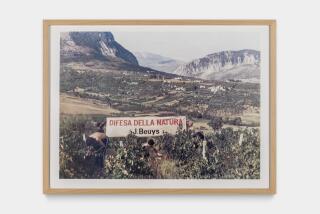Joseph Beuys, Avant-Garde Artist, Dies
BERLIN — Joseph Beuys, one of the most prominent, controversial and colorful figures in West Germany’s postwar avant-garde art world, has died at age 65, it was announced.
Beuys, whose brimmed hat and multi-pocketed coat became familiar through his frequent exposure in the media, made a name for himself principally through his sculptures.
He died Jan. 23 from a heart attack. He had been suffering from a rare inflammation of the lungs since May, said Johannes Stuettgen, an associate.
Beuys (pronounced Joyce), who made an early sculpture out of what had been his baby bathtub, always said anyone could be an artist if he set free his inner creative powers.
His works included felt crucifixes, grease-smeared chairs or arrangements of rabbit parts or toenail clippings.
He also performed in public, often whispering verses from the poet Johann Wolfgang von Goethe before an audience.
Felt and grease were symbols of nourishment and warmth, recurring themes in his more than 15,000 drawings and 30,000 objects. They had become important to him after his Luftwaffe bomber crashed in the Crimean mountains in 1943 and the Tatars who rescued him wrapped him in fat and felt to keep him warm.
In 1947, after brief internment as a British prisoner of war, Beuys began art studies at Duesseldorf’s art academy.
He began teaching at the academy in 1961, but was fired in 1972 for leading a student strike.
A lengthy legal battle eventually succeeded in regaining him the title of professor as well as studio space at the academy, but he could not teach there again.
Instead, he went to Vienna where he accepted a chair at the College of Applied Art in 1979. That was also about the time that he joined West Germany’s pacifist and ecology-minded political party, the Greens. He campaigned actively for the party in 1980.
The market value of his works has increased dramatically in recent years. A felt-covered concert grand piano that sold for about $4,000 in 1967 was sold again seven years later for about $80,000.
When an overzealous cleaning lady scrubbed out what she thought was a filthy bathtub, a judge put the loss at thousands of dollars.
In recent years his works had become increasingly ecological. He launched what he called “urban forestation” projects, one of which involved planting 7,000 oak trees in the city of Kassel. City officials rejected a similar project to plant trees in a bleak harborside neighborhood of Hamburg.
In 1974 he came to the United States but, instead of mounting a traditional exhibit of his works, chose instead to spend a week in his art dealer’s gallery with a live coyote.
Beuys said he intended the gesture as a tribute to the American Indian and the regard in which he held the coyote.
More to Read
The biggest entertainment stories
Get our big stories about Hollywood, film, television, music, arts, culture and more right in your inbox as soon as they publish.
You may occasionally receive promotional content from the Los Angeles Times.










